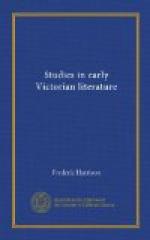Passing from the thought to the form of this famous passage, with what a wealth of illustration is it enforced, with what telling contrasts, with what gorgeous associations! How vivid the images, how stately the personages, who are called up to heighten the lights of the tableau of the Vatican! Ancient and modern civilisation are joined by it; it recalls the Pantheon and the Colosseum; it gave sanction to the Empire of Charlemagne and to that of Napoleon, it inspired Augustin, and confronted Attila; Venice is a mere modern foundation; the Church is older than Hengist and Horsa, Clovis, or Mahomet; yet it stretches over the Atlantic continent from Missouri to Cape Horn, and still goes on conquering and to conquer. And the climax of this kaleidoscopic “symphony in purple and gold”—the New Zealander sketching the ruins of St. Paul’s from a broken arch of London Bridge—has become a proverb, and is repeated daily by men who never heard of Macaulay, much less of Von Ranke, and is an inimitable bit of picturesque colouring. It is very telling, nobly hyperbolic, no man can misunderstand it, or forget it. The most practised hand will not find it easy to “go one better than” Macaulay in a swingeing trope. It is a fascinating literary artifice, and it has fascinated many to their ruin. In feebler hands, it degenerates into what in London journalistic slang is known as “telegraphese.” A pocket encyclopaedia and a copious store of adjectives have enabled many a youth to roar out brilliant articles “as gently as a sucking dove.” But all men of power have their imitators, and are open to parody and spurious coining. Now, Macaulay, however brilliant and kaleidoscopic, is always using his own vast reading, his own warm imagination, his unfailing fecundity, and his sterling good sense.
Turn to the style of the passage—it is perfectly pellucid in meaning, rings on the ear like the crack of a rifle, is sonorous, rich, and swift. One can fancy the whole passage spoken by an orator; indeed it is difficult to resist the illusion that it was “declaimed” before it was written. We catch the oratorial tags and devices, the repeated phrase, the incessant antithesis, the alternate rise and fall of eloquent speech. It is declamation—fine declamation—but we miss the musical undertones, the subtle involutions, the unexpected bursts, and mysterious cadences of really great written prose. The term “the Republic of Venice” is repeated three times in three lines: the term “the Papacy” is repeated three times in two lines. Any other writer would substitute a simple “it” for most of these; and it is difficult to see how the paragraph would lose. The orator aids his hearers by constant repetition of the same term; the writer avoids this lest he prove monotonous. The short sentences of four or five words interposed to break the torrent—the repetition of the same words—the see-saw of black and white, old and young, base and pure—all




